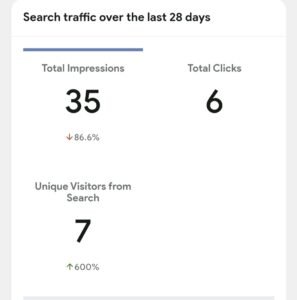Actions taken for recovery after Google Updates on AI and Spam
- Updates are Crucial
- Unpredictability Factor
- Lack of Transparency
- Drastic Fluctuations in Traffic
- Smaller Blogs Disadvantage
- Sense of Uncertainty and Despair
- Our Blog was Destroyed
- Our Recovery Plan
- Frequently Asked Questions
- 1. What should I do if my blog’s traffic drops significantly after a Google update?
- 2. How long does it typically take to recover from a Google update?
- 3. Should I panic and make drastic changes to my blog after a Google update?
- 4. Can hiring an SEO agency help my blog recover from a Google update?
- 5. How can I determine if my blog was penalized by Google after an update?
- 6. Is it advisable to make frequent changes to my blog in response to Google updates?
- 7. How important is it to follow Google’s Webmaster Guidelines for blog recovery after updates?
- 8. Should I focus on creating new content or updating existing content to recover from a Google update?
- 9. How can I improve my blog’s backlink profile to recover from a Google update?
- 10. How can I future-proof my blog against potential Google updates?
- 11. What role do user signals play in blog recovery after a Google update?
- 12. Can improving my blog’s mobile experience help with recovery after a Google update?
- 13. Should I prioritize content quality or quantity when recovering from a Google update?
- 14. How can I leverage social media to aid in blog recovery after a Google update?
- 15. How can I monitor and track the impact of Google updates on my blog’s performance?
Updates are Crucial
Google algorithm updates are crucial for maintaining the relevance and efficiency of the search engine’s results.
However, they can be unsettling for bloggers due to the potential impact on their website’s visibility and traffic. These updates are designed to improve user experience by refining search results, but they often introduce uncertainty and challenges for bloggers striving to maintain or improve their rankings.
Unpredictability Factor
One of the primary reasons why Google algorithm updates unsettle bloggers is the unpredictability factor.
Google regularly releases updates, sometimes multiple times in a year, and these updates can significantly alter search engine ranking factors.
What worked well for a website yesterday might not work tomorrow, leaving bloggers constantly playing catch-up to adapt their strategies.
Lack of Transparency
Furthermore, the lack of transparency surrounding these updates adds to the unease.
While Google occasionally announces major updates like Panda or Penguin, many updates are minor and not officially disclosed.
Bloggers are left to speculate about the changes and decipher their impact on their websites, often resorting to trial and error to regain lost rankings.
Drastic Fluctuations in Traffic
Another source of concern for bloggers is the potential for drastic fluctuations in traffic and revenue following an algorithm update.
A drop in rankings can lead to a significant decrease in organic traffic, affecting ad revenue, affiliate sales, and overall monetization efforts. This instability can be especially challenging for bloggers who rely on their websites as a primary source of income.
Smaller Blogs Disadvantage
Moreover, algorithm updates sometimes prioritize certain types of content over others, favoring authoritative sources or fresh, high-quality content.
This can disadvantage smaller bloggers or those in niche industries, making it harder for them to compete with larger, more established websites.
Sense of Uncertainty and Despair
While Google algorithm updates are necessary for improving search results, they can create a sense of uncertainty and instability for bloggers. Adapting to these changes requires constant vigilance, experimentation, and a willingness to evolve strategies to maintain visibility and traffic in the ever-evolving landscape of online content.
Our Blog was Destroyed
As y’all are aware by now, Google updated its ranking algorithms by releasing a new way to deal with blogs…
We already posted about it on other posts and it bears no repeating. Linked here are the posts we made about the new updates.
We thought our websites had escaped the dragnet. Sigh…

Here’s a screenshot of our much diminished traffic. We lost nearly 90% of our traffic.
Our Recovery Plan
How do we plan to recover? 2 ways
Rewriting content
We are rewriting our content and giving it the human touch.
Focus on Search Query
We are trying to answer relevant search questions.
Deleting Certain Posts
We are deleting certain posts and replacing them with better content or at least what we think is better content.
Resubmit to Google
After we do the above, we shall resubmit our content to Google for indexing.
Do tell us what you are doing, to recover.
Posted on 8th March 2024
Frequently Asked Questions
1. What should I do if my blog’s traffic drops significantly after a Google update?
After a significant drop in traffic following a Google update, it’s crucial to assess your website’s content quality, relevance, and overall user experience. Start by conducting a comprehensive audit of your site to identify any issues that may have triggered the drop. Look for duplicate content, thin or low-quality content, keyword stuffing, or any other practices that might violate Google’s guidelines.
Next, focus on improving your content quality by creating in-depth, informative, and engaging posts that genuinely add value to your audience. Update outdated content, optimize on-page SEO elements, and ensure your website is mobile-friendly and loads quickly.
Additionally, consider diversifying your traffic sources by investing in social media marketing, email campaigns, and building backlinks from reputable websites in your niche. By implementing these strategies, you can not only recover from the traffic drop but also future-proof your blog against potential algorithm updates.
2. How long does it typically take to recover from a Google update?
The time it takes to recover from a Google update varies depending on the severity of the impact and the extent of the changes required to align with Google’s new algorithms. In some cases, minor fluctuations in traffic can resolve themselves within a few days as Google’s algorithms reevaluate and index your website. However, for more significant drops, recovery may take weeks or even months.
To expedite the recovery process, focus on implementing necessary changes promptly, such as improving content quality, fixing technical issues, and adhering to Google’s Webmaster Guidelines. Monitor your website’s performance closely using tools like Google Analytics and Google Search Console to track progress and identify any further areas for improvement.
Remember that recovery is not guaranteed, and it’s essential to continuously adapt your SEO strategy to align with Google’s evolving algorithms and industry best practices.
3. Should I panic and make drastic changes to my blog after a Google update?
Panic-induced, drastic changes to your blog following a Google update can often do more harm than good. Instead of reacting impulsively, take a step back and assess the situation objectively. Begin by analyzing the specific reasons behind the traffic drop, such as changes in ranking factors, penalties, or increased competition.
Once you’ve identified the root cause, develop a well-thought-out strategy for addressing the issues methodically. Focus on making incremental improvements to your website’s content, user experience, and SEO practices rather than implementing sweeping changes that may disrupt your site’s organic growth.
Remember that SEO is a long-term game, and knee-jerk reactions can lead to further instability and potential penalties from search engines. By maintaining a calm and strategic approach, you’ll be better equipped to navigate the challenges posed by Google updates and emerge stronger in the long run.
4. Can hiring an SEO agency help my blog recover from a Google update?
Hiring an experienced SEO agency can be instrumental in helping your blog recover from a Google update, especially if you lack the expertise or resources to address the issues independently. However, it’s essential to choose a reputable agency with a proven track record of success and a deep understanding of Google’s algorithms and best practices.
Before engaging an SEO agency, thoroughly research their credentials, client testimonials, and case studies to ensure they have the expertise and ethical standards necessary to drive positive results for your blog. Additionally, clearly communicate your goals, expectations, and budget constraints to ensure alignment and transparency throughout the engagement.
A reputable SEO agency can provide valuable insights, strategic guidance, and hands-on support to optimize your website, improve its visibility in search results, and recover from the impact of Google updates. Collaborating with experts can expedite the recovery process and position your blog for long-term success in the competitive online landscape.
5. How can I determine if my blog was penalized by Google after an update?
Determining whether your blog was penalized by Google after an update requires careful analysis of your website’s performance metrics, search engine rankings, and messages from Google Search Console. Look for sudden drops in organic traffic, significant declines in keyword rankings, or manual actions issued by Google.
If you suspect a penalty, log in to Google Search Console and check for any notifications or manual actions related to your website. Google will typically notify you if your site violates its Webmaster Guidelines or if manual actions are taken against it.
Additionally, monitor your website’s backlink profile for any suspicious or low-quality links that may trigger algorithmic penalties. Use tools like Google Analytics to track changes in traffic patterns and identify potential issues affecting your site’s visibility in search results.
If you confirm that your blog has been penalized, take immediate steps to rectify the issues, such as removing spammy links, improving content quality, and submitting a reconsideration request to Google if applicable. By addressing the root causes of the penalty and demonstrating your commitment to compliance with Google’s guidelines, you can work towards recovering your website’s rankings and visibility.
6. Is it advisable to make frequent changes to my blog in response to Google updates?
Making frequent changes to your blog in response to every Google update is not advisable and can potentially harm your website’s stability and long-term performance. Instead of reacting impulsively to every algorithm tweak, focus on developing a robust, sustainable SEO strategy based on best practices and industry trends.
Regularly monitor your website’s performance using tools like Google Analytics and Google Search Console to identify any fluctuations or anomalies in traffic and rankings. If you notice significant drops or changes, conduct a thorough analysis to determine the underlying causes before implementing targeted adjustments.
When making changes to your blog, prioritize quality over quantity and ensure that any updates align with Google’s Webmaster Guidelines and user experience principles. Avoid engaging in black hat SEO tactics or manipulative practices that could result in penalties or algorithmic demotions.
By maintaining a steady course and making informed, data-driven decisions, you can mitigate the impact of Google updates and build a resilient online presence that withstands algorithmic fluctuations over time.
7. How important is it to follow Google’s Webmaster Guidelines for blog recovery after updates?
Following Google’s Webmaster Guidelines is paramount for blog recovery after updates, as non-compliance can lead to penalties, ranking drops, and long-term damage to your website’s reputation and visibility in search results. Google’s guidelines outline best practices for creating high-quality, user-focused websites that provide value and relevance to searchers.
By adhering to these guidelines, you demonstrate your commitment to ethical SEO practices and ensure that your website remains in good standing with Google’s algorithms. This includes avoiding tactics like keyword stuffing, cloaking, link schemes, and other manipulative techniques that can trigger penalties or algorithmic demotions.
Additionally, following Google’s guidelines helps improve your website’s overall user experience, which is a crucial ranking factor in Google’s algorithms. By prioritizing quality content, intuitive navigation, fast page loading speeds, and mobile responsiveness, you can enhance user satisfaction and increase the likelihood of ranking well in search results.
Ultimately, aligning with Google’s Webmaster Guidelines not only helps facilitate blog recovery after updates but also fosters sustainable, long-term growth and success in organic search.
8. Should I focus on creating new content or updating existing content to recover from a Google update?
Both creating new content and updating existing content are essential strategies for recovering from a Google update and improving your blog’s overall performance in search results. While creating new content allows you to target additional keywords, topics, and audience segments, updating existing content can help enhance its relevance, freshness, and value to users.
Start by conducting a content audit to identify gaps, opportunities, and areas for improvement in your existing content library. Look for outdated, underperforming, or thin content that could benefit from updates or consolidation. Focus on optimizing title tags, meta descriptions, headings, and body copy to align with current search intent and keyword trends.
Simultaneously, develop a content strategy that prioritizes the creation of high-quality, evergreen content that addresses your audience’s needs, pain points, and interests. Conduct keyword research to identify relevant topics and search queries with sufficient search volume and low competition, then create comprehensive, well-researched articles that provide unique insights and value.
By striking a balance between creating new content and updating existing content, you can maximize your blog’s visibility, engagement, and relevance in search results, ultimately driving sustainable organic traffic growth over time.
9. How can I improve my blog’s backlink profile to recover from a Google update?
Improving your blog’s backlink profile is crucial for recovering from a Google update and enhancing your website’s authority, trustworthiness, and relevance in search results. Start by conducting a thorough audit of your existing backlinks to identify any low-quality, spammy, or irrelevant links that could be harming your site’s reputation.
Next, focus on acquiring high-quality, relevant backlinks from authoritative websites in your niche through strategic outreach, content marketing, and relationship building. Create compelling, shareable content that naturally attracts links from other websites, such as industry reports, expert roundups, infographics, and original research.
Additionally, leverage social media platforms, online communities, and industry influencers to amplify your content and attract organic backlinks. Engage in guest blogging opportunities, podcast interviews, and collaborative projects to expand your reach and establish credibility within your industry.
Finally, monitor your backlink profile regularly using tools like Ahrefs, Moz, or SEMrush to track new links, identify potential issues, and disavow toxic links if necessary. By proactively managing your backlink profile and focusing on quality over quantity, you can strengthen your blog’s authority and resilience against future Google updates.
10. How can I future-proof my blog against potential Google updates?
Future-proofing your blog against potential Google updates requires a proactive, holistic approach to SEO that prioritizes user experience, content quality, and ethical optimization practices. Start by staying informed about industry trends, algorithm changes, and Google’s Webmaster Guidelines to anticipate potential shifts in search engine rankings and adjust your strategy accordingly.
Invest in creating high-quality, evergreen content that provides genuine value and relevance to your target audience. Conduct keyword research to identify emerging topics, trends, and search queries with long-term potential, then create comprehensive, well-optimized content that addresses user intent and solves their problems.
Focus on improving your website’s technical performance, including page speed, mobile responsiveness, and security, to enhance user experience and meet Google’s ranking criteria. Implement structured data markup to make your content more accessible and informative to search engines, potentially earning rich snippets and enhanced search features.
Additionally, diversify your traffic sources by leveraging social media, email marketing, and other digital channels to reduce reliance on organic search traffic alone. Cultivate relationships with industry influencers, thought leaders, and authoritative websites to earn natural backlinks and increase your website’s visibility and authority.
By adopting a proactive, multi-faceted approach to SEO, you can future-proof your blog against potential Google updates and position it for sustained growth and success in the competitive online landscape.
11. What role do user signals play in blog recovery after a Google update?
User signals, such as click-through rate (CTR), bounce rate, dwell time, and conversion rate, play a significant role in blog recovery after a Google update. These metrics provide valuable insights into how users interact with your website and content, directly influencing your site’s rankings and visibility in search results.
Following a Google update, monitor user signals closely using tools like Google Analytics and Google Search Console to identify any changes or anomalies in user behavior. If you notice declines in CTR, increases in bounce rate, or decreases in dwell time, it may indicate that your content is not meeting user expectations or satisfying search intent.
To improve user signals and facilitate blog recovery, focus on creating compelling, relevant meta titles and descriptions that entice users to click through to your website. Ensure that your content delivers on its promises and provides valuable information that keeps users engaged and encourages them to explore further.
Additionally, optimize your website’s navigation, internal linking structure, and call-to-action elements to guide users through their journey and encourage conversions. By prioritizing user satisfaction and engagement, you can enhance your blog’s performance in search results and recover from the impact of Google updates more effectively.
12. Can improving my blog’s mobile experience help with recovery after a Google update?
Improving your blog’s mobile experience can significantly contribute to recovery after a Google update, as mobile-friendliness is a critical ranking factor in Google’s algorithms. With the increasing prevalence of mobile search, Google prioritizes websites that provide a seamless, responsive user experience across all devices, including smartphones and tablets.
Start by conducting a mobile usability audit using Google’s Mobile-Friendly Test or tools like PageSpeed Insights to identify any issues or opportunities for improvement. Ensure that your website’s design, layout, and content display adapt seamlessly to different screen sizes and resolutions, providing a consistent and intuitive experience for mobile users.
Optimize your website’s loading speed by compressing images, minifying CSS and JavaScript files, and leveraging browser caching to reduce page load times on mobile devices. Implement mobile-first design principles, such as larger font sizes, touch-friendly buttons, and streamlined navigation, to enhance usability and accessibility for mobile users.
By prioritizing mobile optimization, you not only improve your website’s rankings in mobile search results but also enhance user satisfaction and engagement, contributing to overall blog recovery and long-term success in organic search.
13. Should I prioritize content quality or quantity when recovering from a Google update?
While both content quality and quantity are important factors in blog recovery after a Google update, prioritizing content quality is ultimately more beneficial for long-term success. Google’s algorithms prioritize websites that provide valuable, relevant, and authoritative content that meets the needs and interests of users.
Instead of focusing solely on producing a high volume of content, concentrate on creating in-depth, comprehensive articles that thoroughly address topics and provide unique insights or perspectives. Conduct thorough research, cite credible sources, and strive to add value to your audience by answering their questions, solving their problems, or fulfilling their needs.
Additionally, prioritize content optimization by incorporating relevant keywords, optimizing meta tags, headings, and image alt text, and structuring your content for readability and user engagement. Ensure that your content is well-written, error-free, and visually appealing to enhance user experience and encourage sharing and engagement.
By prioritizing content quality over quantity, you not only improve your blog’s credibility and authority but also increase the likelihood of ranking well in search results and recovering from the impact of Google updates more effectively.
14. How can I leverage social media to aid in blog recovery after a Google update?
Social media can be a valuable tool for aiding in blog recovery after a Google update by driving traffic, engagement, and visibility to your website’s content. Start by identifying the social media platforms that are most popular among your target audience and establish a presence on those channels.
Share your blog posts, articles, and other content across your social media profiles, accompanied by compelling captions, visuals, and hashtags to maximize visibility and engagement. Encourage followers to like, comment, share, and interact with your posts to increase reach and amplify your content’s impact.
Engage with your audience by responding to comments, addressing questions, and participating in relevant discussions to build rapport and establish credibility within your niche. Collaborate with influencers, industry experts, and other content creators to expand your reach and attract new followers and visitors to your blog.
Additionally, use social media advertising platforms, such as Facebook Ads or LinkedIn Ads, to target specific demographics, interests, and behaviors and drive targeted traffic to your website’s content. By leveraging social media effectively, you can supplement organic search traffic, enhance brand visibility, and accelerate blog recovery after Google updates.
15. How can I monitor and track the impact of Google updates on my blog’s performance?
Monitoring and tracking the impact of Google updates on your blog’s performance is essential for identifying trends, patterns, and areas for improvement. Start by setting up Google Analytics and Google Search Console for your website to access valuable insights into traffic, rankings, and user behavior.
Regularly review key performance metrics, such as organic traffic, keyword rankings, click-through rate, bounce rate, and conversion rate, to identify any fluctuations or anomalies that may be attributed to Google updates. Look for correlations between algorithm changes and changes in your website’s performance to gauge the impact and prioritize areas for optimization.
Use tools like SEMrush, Ahrefs, Moz, or Rank Ranger to monitor keyword rankings, track backlinks, and analyze competitor performance to gain additional insights into the broader SEO landscape. Subscribe to industry blogs, forums, and newsletters to stay informed about upcoming Google updates, algorithm changes, and best practices for SEO.
By staying vigilant and proactive in monitoring your blog’s performance, you can quickly identify and respond to the impact of Google updates, implement targeted optimizations, and position your website for recovery and long-term success in organic search.


